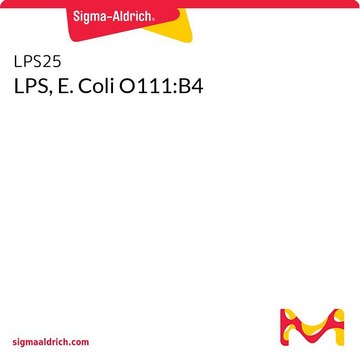SMB00704
Lipopolysaccharides from Proteus mirabilis
purified by phenol extraction
Sinonimo/i:
LPS
Autenticatiper visualizzare i prezzi riservati alla tua organizzazione & contrattuali
About This Item
Prodotti consigliati
Origine biologica
bacterial (Proteus mirabilis)
Livello qualitativo
Stato
lyophilized powder
Purificato mediante
phenol extraction
Impurezze
<3.00% protein (Lowry-TCA)
Colore
white to faint yellow
Solubilità
water: 0.90-1.10 mg/mL, slightly hazy to hazy, colorless to light yellow
Condizioni di spedizione
ambient
Temperatura di conservazione
2-8°C
Descrizione generale
Lipopolysaccharides (LPS′s) are complex glycolipids that are characteristic components of the cell wall of Gram-negative bacteria. They consist of a lipid A moiety linked to an antigenic O-polysaccharide.
Proteus mirabilis is a Gram-negative facultative anaerobic rod-shaped bacterium. Bacteria of the genus Proteus of the family Enterobacteriaceae are opportunistic human pathogens responsible for wound and burn infections as well as skin, eye, ear, nose, throat, urinary tract, and gastrointestinal infections and bacteremias.
Proteus mirabilis is a Gram-negative facultative anaerobic rod-shaped bacterium. Bacteria of the genus Proteus of the family Enterobacteriaceae are opportunistic human pathogens responsible for wound and burn infections as well as skin, eye, ear, nose, throat, urinary tract, and gastrointestinal infections and bacteremias.
Applicazioni
- Lipopolysaccharide structure modulates cationic biocide susceptibility and crystalline biofilm formation in Proteus mirabilis.: The study explores how variations in lipopolysaccharide structure affect the susceptibility of Proteus mirabilis to biocides and its ability to form crystalline biofilms, informing strategies to combat biofilm-associated infections (Clarke et al., 2023).
Azioni biochim/fisiol
Lipopolysaccharide (LPS) and its lipid A moiety stimulate cells of the innate immune system by the toll-like receptor 4 (TLR4), a member of the toll-like receptor protein family, which recognizes common pathogen-associated molecular patterns (PAMPs). Lipid A plays a role in the biological properties attributed to endotoxic LPS. LPS is a highly immunogenic antigen that has the ability to enhance immune responses.The outer-membrane lipopolysaccharide is considered an important virulence factor of Proteus. It has been suggested that the immunological response against P. mirabilis, LPS might play a role in rheumatoid arthritis. A possible correlation between the abundance of P. mirabilis in the intestine and obesity was suggested recently. The purified LPS from P. mirabilis OXK is used in the Weil-Felix test for the diagnosis of rickettsiosis (scrub typhus) caused by the bacterium Orientia (Rickettsia) tsutsugamushi.
Nota sulla preparazione
Soluble in water and cell culture medium DMEM (1 mg/mL) yielding a clear to slightly hazy solution.
Altre note
To gain a comprehensive understanding of our extensive range of Lipopolysaccharides for your research, we encourage you to visit our Carbohydrates Category page.
Prodotti correlati
N° Catalogo
Descrizione
Determinazione del prezzo
Codice della classe di stoccaggio
11 - Combustible Solids
Classe di pericolosità dell'acqua (WGK)
WGK 3
Punto d’infiammabilità (°F)
Not applicable
Punto d’infiammabilità (°C)
Not applicable
Scegli una delle versioni più recenti:
Certificati d'analisi (COA)
Lot/Batch Number
Non trovi la versione di tuo interesse?
Se hai bisogno di una versione specifica, puoi cercare il certificato tramite il numero di lotto.
Possiedi già questo prodotto?
I documenti relativi ai prodotti acquistati recentemente sono disponibili nell’Archivio dei documenti.
I clienti hanno visto anche
A S Swierzko et al.
Biochemistry. Biokhimiia, 62(1), 21-27 (1997-01-01)
Sugar analysis and 1H- and 13C-NMR spectroscopic studies showed that various strains of Proteus mirabilis OXK used as antigens in the Weil-Felix test for serodiagnosis of rickettsiosis (scrub typhus) produce lipopolysaccharides (LPSs) with the same O-specific polysaccharide chain having the
Distribution of core oligosaccharide types in lipopolysaccharides from Escherichia coli.
Amor K, et al.
Infection and Immunity, 68(3), 1116-1124 (2000)
Analysis of Lipopolysaccharides of Gram-Negative Bacteria
Mayer H, Tharanathan RN, Weckesser J
Methods in Microbiology, 18, 157-207 (1985)
Molecular basis for structural diversity in the core regions of the lipopolysaccharides of Escherichia coli and Salmonella enterica.
Heinrichs D E, et al.
Molecular Microbiology, 30(2), 221-232 (1998)
Novel adjuvants & delivery vehicles for vaccines development: a road ahead.
Mohan T, et al.
The Indian Journal of Medical Research, 138(5), 779-795 (2013)
Il team dei nostri ricercatori vanta grande esperienza in tutte le aree della ricerca quali Life Science, scienza dei materiali, sintesi chimica, cromatografia, discipline analitiche, ecc..
Contatta l'Assistenza Tecnica.


